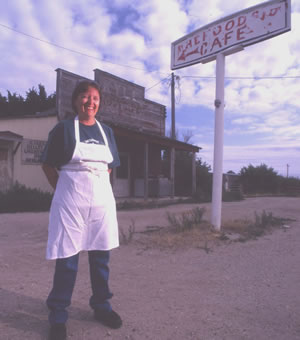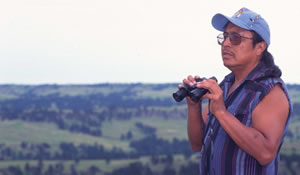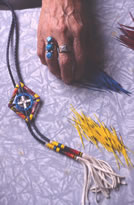|
|
On Main Street in Kyle, S.D., Carol Vocu stands outside her restaurant, The Food Stop Cafe. Established in 1991, Vocu's business has grown with help from The Lakota Fund, which provided technical assistance and loans ranging from $1,000 to $14,000. Johnny Sundby, Dakota Skies Photography |
Electrician Darwin Eagle Elk, restaurant proprietor Carol Vocu and many other entrepreneurs on the Pine Ridge Indian Reservation (Pine Ridge) learned the lessons of running a small business from The Lakota Fund (TLF). A private, nonprofit community development financial institution, TLF was established to provide capital and technical assistance for the development of a private-sector economy on Pine Ridge.
Loan funds in briefIn areas with underdeveloped private sectors, loan funds often play a critical role, providing credit and technical assistance to local small businesses. Capital for loan funds comes from a variety of sources, including federal, state and tribal government; private banks; corporations; individual investors and foundations. Often, loan funds fill financing gaps that occur when businesses cannot meet conventional financing requirements. Loan funds consider whether a borrower has a viable business plan, the managerial skills to execute the plan and intangibles such as a personal commitment to succeed, rather than concentrating solely on a borrower's historical repayment ability and collateral. This holistic approach to borrower eligibility makes loan funds a good fit for Indian Country communities, where low incomes and nonexistent credit histories have kept potential entrepreneurs from tapping into sources of conventional small business financing. |
In the 14 years since TLF was established, many economic development agencies and organizations in Indian Country have created loan funds to assist reservation-based enterprises. When they are well-designed and well-managed, loan funds can be a vital component of a healthy reservation economy, helping create jobs and wealth.
|
|
Marcell Bull Bear surveys his 3,100-acre ranch south of Kyle, S.D. A 1999 loan from TLF helped Bull Bear expand operations at Kiyaksa Buffalo & Cattle Company. "Thanks to TLF's technical and financial assistance, I've come this far," Bull Bear says. Johnny Sundby, Dakota Skies Photography |
Lessons learned
In those 14 years, the managers of TLF learned important lessons from their experiences. Following are 10 of those lessons. They are not lessons in raising funds or designing a capital structure. Instead, they are lessons learned through the daily interactions among fund managers, borrowers and other community members. By sharing these lessons learned in Indian Country, TLF hopes to benefit all community developers.
Lesson 1: Establish and follow your mission
TLF's mission has been clear from the start: to develop a private sector on Pine Ridge that will provide jobs, offer products and services close to home and keep money on the reservation. However, to fulfill this mission, TLF has learned that capital must be made available to businesses of varying sizes and not just to the smallest businesses. A robust private sector cannot consist primarily of very small businesses. It must include larger businesses as well, to create significant wealth and employ individuals who do not wish to run their own firms.
Lesson 2: Know and meet your market's needs
Elsie Meeks, executive director of TLF, notes that fund managers must be aware of the full range of funding needs in the community, even if their organization's mission is to only make loans of a certain size. When it started operating, TLF offered micro loans to very small businesses. According to Meeks, other lenders were not making larger loans on Pine Ridge. So, as TLF gained experience, and in order to follow its mission, the fund raised its lending limit from $10,000 to $25,000. TLF then increased the limit to 6 percent of the fund's capital, up to a maximum of $200,000.
Lesson 3: Be flexible and learn as you go
At its start, TLF's lending policy relied not on credit histories but on the philosophy that "character makes the difference" in loan repayment. The reliance on character lending forced staff members to constantly defend their decisions to deny credit, a hard task in a small community where borrowers are the friends and relatives of the lenders.
To counteract these problems, TLF began a circle lending program based on the model pioneered by the Grameen Bank in Bangladesh. (For more information on the Grameen Bank, visit www.grameen-info.org.) Potential borrowers received training before any money was lent, and other circle members took part in the lending decisions, which took some of the pressure off TLF's staff. Also, by observing the circles, staff members learned about group dynamics, which helped them devise lending policies and collection procedures appropriate for the reservation.
Circle lending provided a valuable learning experience for the staff, but it could not fulfill TLF's basic mission of building a private sector on the reservation. Circle loans were capped at $1,000, so borrowers were overwhelmingly "mom and pop" operations. By 1999, TLF managers recognized that such small-scale businesses with limited growth potential would not lead to a vibrant private sector and decided to end the circle-lending program.
|
Johnny Sundby, Dakota Skies Photography |
Johnny Sundby, Dakota Skies Photography |
Lesson 4: Approach new ventures with caution
Decent, affordable housing has always been a critical need on Pine Ridge. Several years ago, TLF managers decided that the lack of such housing was impeding local economic development and, despite their lack of experience in housing development, decided to tackle the problem by constructing affordable housing. Unfortunately, managers saw the construction drain resources from the core activity of lending to small businesses. TLF later curtailed its housing development efforts.
The experience taught TLF managers to wade into new project areas slowly, with guidance from experts in the field, instead of diving in quickly—especially when significant resources may have to be committed to the new project.
Lesson 5: Learn from others, then learn from experience
In the early days of TLF, the staff had little lending experience and countered the problem through the use of outside resources. "We relied on a lot of people in those days," comments Meeks. TLF received templates for loan policies, collection procedures, liquidity and loan reserves and loan status reports from other funds and lenders. First Nations Development Institute (First Nations) provided training for TLF's staff and, for the first five years of the fund's operations, administered the larger of its two loan programs, which allowed loans up to $10,000.
The arrangement with First Nations was designed to allow time for the inexperienced staff of TLF to learn how to lend. However, with First Nations administering the larger loan program from its offices in the state of Virginia, TLF staffers in Kyle were left managing the smaller, $1,000-limit loan program. The process of making only the small loans did not demand that staff learn and rigorously apply principles of business lending. Not until 1992, when TLF assumed authority for making loans under both programs, did TLF staff learn how to lend. According to Meeks, "We didn't grow and learn until we were left on our own, to make our own decisions and to deal with the consequences of those decisions."
|
|
Rosie Olson displays the wares at Singing Horse Trading Post, located seven miles north of Manderson, S.D., on Pine Ridge. Established in 1995 by Rosie and her husband, Howard, the business sells leather, beads and other supplies to local artisans. TLF provided the Olsons with technical assistance and a $25,000 loan, which was used to construct a bed and breakfast. Johnny Sundby, Dakota Skies Photography |
Lesson 6: Hire staff with the "right stuff"
A loan fund's success or failure is largely dependent on its employees. In the case of TLF, managers credit much of their success to hiring staffers with the right combination of abilities and experience to administer the fund well.
TLF managers always made it a priority to hire local residents who know the community and could help implement the fund's policy of character-based lending. However, local knowledge was no substitute for knowledge of and experience in lending. Meeks says she now looks for a balance. She favors staffers who are local residents but, as the fund moves into making larger loans, plans to hire for expertise and hire outsiders as needed. Hiring experienced staff from outside the organization can accelerate the training of current staff members as they learn from the expert. The hoped-for outcome is that the "outsiders" hired for their expertise will become familiar with the community, while the skills and experience of locally hired staff continue to increase.
But Meeks insists that all staff she hires, whether local or from another community, must have two key characteristics: integrity and the strength and courage—or as she puts it, the "guts"—to take on tough work. She says that business lending is difficult and business lending in Indian Country is especially difficult. Local or not, experienced or not, loan fund employees must be strong and committed to upholding the values and standards of the fund.
Lesson 7: Be diligent to keep delinquencies in check
According to Meeks, managing delinquent loans has always been and will always be an issue for TLF. While losses were 10 percent in 1999, Meeks thinks the rate could easily rise to 50 percent or more if fund managers are not constantly diligent. TLF's policies clearly emphasize to staff and borrowers alike that it makes loans, not grants, and that repayment according to schedule is expected. Staff members receive training in loan monitoring and collections procedures. To stay on top of the loans, staff members meet weekly to discuss loans, perform site visits to see how businesses are doing, and receive training in the fundamentals of the businesses in TLF's portfolio.
|
|
Darwin Eagle Elk provides electrical services for a customer on Pine Ridge. His firm, Eagle Elk Services, was established in 1995 and has continuous contracts with area businesses. TLF has helped Eagle Elk with technical assistance and loans ranging from $1,000 to $7,000. Johnny Sundby, Dakota Skies Photography |
Lesson 8: Accept and manage risks
On average, loans made by a fund such as TLF are inherently riskier than loans made by a commercial bank. This is true because loan funds often work with borrowers that are not "bankable"; that is, they do not have a low enough risk profile or sufficient collateral to receive a bank loan.
According to Meeks, community development loan fund managers must understand that, given the mission of such funds, their loans are risky and some will not be repaid. Then, management must control the risk. First, the fund must set reasonable delinquency and loan loss targets and make it a top priority to not exceed them. Second, the fund must use good, basic, lending practices. In Meeks's view, this means the fund must establish and consistently apply lending criteria based on ratios, collateral policies and such. Last, but by no means least, the fund must establish and maintain a good loan tracking system and, as discussed above, have a commitment to and system for collections. While these steps seem daunting, Meeks notes that TLF has involved bankers and other lenders as advisors—advisors who have helped the fund construct and implement loan fund policies and systems.
Lesson 9: Develop borrowers through training and investment
Although TLF abandoned the circle lending approach, it incorporated the lessons learned during the circle program's operation. First, TLF managers determined that borrowers usually did not understand what it meant to be in business and that owning a business requires a total commitment. With an unemployment rate of 85 percent, many residents of Pine Ridge have never worked in a business or held a regular job.
Second, fund managers learned that it is essential to the eventual repayment of the loan that borrowers invest something of themselves in the process. Since borrowers on Pine Ridge often have few or no assets to offer as security on a loan, the "something of themselves" that they must invest has to be another scarce commodity—time.
The fund requires potential borrowers to attend seven weeks of business preparation classes. As evidence of their seriousness and commitment, potential borrowers must have perfect attendance at all classes and fulfill all assignments before they can qualify for a loan. The classes prepare potential business owners for the realities and hard work of owning a business and dissuade the less committed from borrowing funds and starting businesses.
Lesson 10: Don't mix politics with private-sector lending
Often in Indian Country, the tribal government controls the reservation's loan fund. According to Meeks, in the end, these funds invariably pursue goals other than developing profitable businesses, such as providing jobs or filling spaces in a shopping center.
In Meeks's opinion, if developing a private sector is the goal, lending decisions must be made free from the political considerations that inevitably creep into tribally controlled funds. Lending staff must be able to make, deny and collect loans free from political pressure, no matter how well-intentioned that pressure may be. In her view, only funds that are controlled by a body independent from the tribal government will have that freedom and be able to foster the successful private businesses necessary to develop a private sector on a reservation.
The final lesson
The lessons learned by established Indian Country loan funds like TLF provide a primer for the development of other loan funds, in Indian Country and elsewhere. Implicit in the lessons learned by TLF is a final lesson—perhaps the most important lesson of all: operating a thriving loan fund, just like operating a thriving small business, requires hard work, perseverance, and an adherence to basic business principles. That lesson is key to the success of small business owners like Darwin Eagle Elk and Carol Vocu, and key to the success of TLF as well.
Pine Ridge and The Lakota Fund: Then and nowThe Lakota Fund (TLF) was established to assist the Oglala Lakota Nation on the Pine Ridge Indian Reservation in southwestern South Dakota. TLF operates out of Kyle, South Dakota, in the geographic center of Pine Ridge. The reservation covers roughly 2 million acres and is home to about 22,000 people. At the time TLF was organized, Pine Ridge had fewer than 40 small businesses, most owned by non-Indians. According to a 1983 study by First Nations Development Institute (First Nations), the lack of local businesses caused some $74 million to flow off the reservation to neighboring towns each year. Rampant unemployment and inadequate housing added to the reservation's economic woes. In 1986, First Nations created TLF as an economic development project. According to Elsie Meeks, executive director of TLF, First Nations provided start-up support, which allowed the fund time to become operational while shielding it from political interference. First Nations' support also helped TLF build its local capacity and develop relationships with national funders. In 1992, First Nations spun off TLF and it became an independent organization. TLF fulfills its mission by providing small business loans and technical assistance to members of the Oglala Lakota Nation. It has lent more than $1.6 million to more than 400 borrowers, helping to create a private-sector economy on Pine Ridge and lessening the flow of money off the reservation. In addition, TLF has initiated and operated a marketing program and opened a retail gift shop to assist artists; obtained funding for and constructed a 13,000-square-foot building to provide office space for TLF and other businesses; developed—with the help of the Small Business Administration—a Tribal Business Information Center, making PCs and Internet access available to borrowers; constructed a 30-unit affordable housing project and provided housing loan packaging for individuals who wished to obtain funds from the U.S. Department of Agriculture's Rural Development program. Recently, TLF received certification as a Community Development Financial Institution (CDFI) from the Department of Treasury's CDFI Fund, making it one of only two reservation-based loan funds to receive this certification. For more information, visit www.lakotafund.org. |
Use of "Indian Country"The term "Indian Country" is commonly used to refer to tribal lands. Congress defined it first in 1948 in a federal criminal statute. See 18 U.S.C. § 1151. The Supreme Court also borrowed this definition for several civil cases. See DeCoteau vs. District County Court, 420 U.S. 425, 427 n. 2 (1975). Generally, the courts have defined Indian Country broadly to include formal and informal reservations, dependent Indian communities and Indian allotments, whether restricted or held in trust by the United States. |











